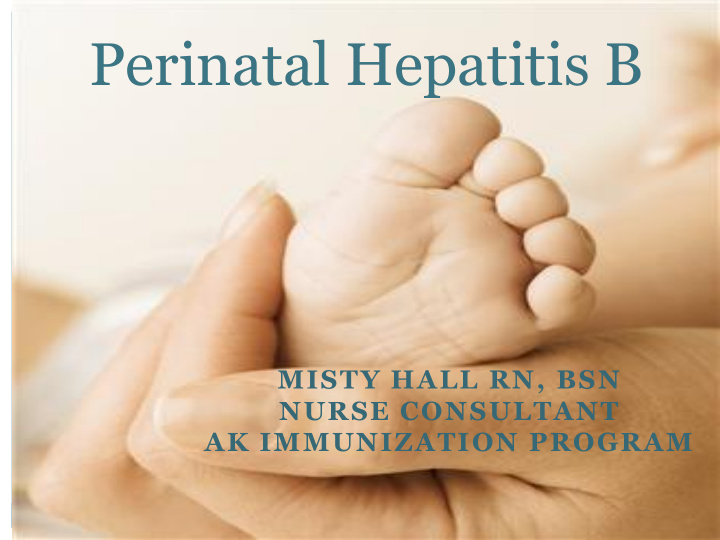



Perinatal Hepatitis B MISTY HALL RN, BSN NURSE CONSULTANT AK IMMUNIZATION PROGRAM
Perinatal Case Management Importance of Birth Dose to End Hepatitis B in Newborns was addressed yesterday Goals: Identify perinatal cases Ensure newborns receive Hepatitis B Immune Globulin (HBIG) and Hepatitis B vaccine within 12 hours of birth High-risk infants complete valid Hepatitis B vaccine series Correct Post Vaccination Serology Testing
Case Management Process Case management starts with the receipt of a lab report Alaska Statute 18.15.370 Hepatitis B is a mandatory reportable condition in Alaska Lab reports are from AK Stars & facsimiles Inclusion criteria: Female Childbearing age 10-50 years Lab – Hepatitis B surface antigen (HBsAg) positive Exclusion criteria: Male Outside of age range All other labs
Prenatal Process Once inclusion criteria is met provider is contacted Information requested: Pregnancy Estimated date of confinement (EDC) Delivery hospital Pediatrician Insurance status Demographics
Delivery Process Delivery hospital is notified of the case Fairbanks Fax to labor and delivery 3 weeks prior to EDC All other birthing hospitals Fax to labor and delivery on date of EDC Infant should receive HBIG & Hepatitis B vaccine within 12 hours of birth
Infant Process Run weekly HBIG report Identifies all infants provided HBIG in the past week A release of information request is faxed to medical records Information requested: Mother’s discharge summary & labs Infant(s) birth & discharge summary & medical administration record Purpose: Identify if HBIG recipient is a true perinatal case Unknown maternal HBsAg status infants should receive HBIG Provide documentation on: Time of birth Birth weight Time of HBIG & Hepatitis B vaccination Identify pediatrician Insurance status
Hepatitis B Vaccine Process Provider is notified 2-3 weeks prior to vaccine being due 4 dose series with Pediarix Birth, 1-2 months, 4 months & 6 months of age Since, the third immunization at 4 months of age falls outside the recommended interval, this dose is not considered valid for Hepatitis B series completion 3 dose series with stand-alone Hepatitis B vaccines Birth, 1-2 months & 6 months of age Please note the last dose of the series must be on or after 6 months of age (24 weeks)
High-Risk Low Birth Weight Infants If mother’s Hepatitis B status is positive or unknown and infant weighs less than < 2 kg (4.4 lbs) at birth Administer HBIG and pediatric Hepatitis B vaccine within 12 hours of birth Because of potentially reduced immunogenicity 3 additional doses of Hepatitis B vaccine should be administered whenever the infant reaches the chronological age of one month Administer at birth, 1 month, 2 months and 6 months of age
Post Discharge Process Pediatrician is contacted to identify patients under Perinatal Hepatitis B case management Prevention checklist is faxed to provider
Post Vaccination Serology Testing Requirements Must be a minimum of 9 months of age, and Must be 1 month after last Hepatitis B vaccine Laboratory tests Hepatitis B Surface Antigen (HBsAg), and Hepatitis B Surface Antibody (Anti-HBs)
PVST Testing should not be done before 9 months of age Minimizes likelihood of detecting passively transferred anti-HBs from HBIG and Maximizes likelihood of detecting late HBsAg-positive infections Recommend testing be done between 9 and 12 months of age Total Hepatitis B core antibody (anti-HBc) testing is not generally recommended for PVST Passively acquired maternal anti-HBc might be detected up to 24 months of age
PVST Follow Up Process Close case: HBsAg – negative Anti-HBs – positive Active case: If both labs were not completed infant remains a case Provider contacted to complete serology HBsAg (-) & Anti-HBs (-) Revaccinate with second series of pediatric Hepatitis B 3 dose interval - 0, 1 & 6 months Perform HBsAg & Anti-HBs testing 1-2 months after vaccine completion
Barriers Lack of notification for Hepatitis B Chronic disease with subsequent pregnancy Undefined contact staff Provider office Hospital Time delay Receipt of medical records - varied turn around time Transient population Language barrier
Solutions Open lines of communication Key staff member at provider facilities and hospitals identified – case management Improved turn around time for requested records Education Webinars Site visits
Resources http://www.immunize.org/protect-newborns/ http://www.epi.hss.state.ak.us/id/iz/hbv/default.htm http://www.cdc.gov/hepatitis/B/PatientEduB.htm http://hepbunited.org/ http://www.hepbmoms.org/
Recommend
More recommend